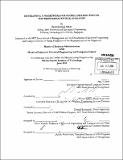| dc.contributor.advisor | Chris Caplice and Donald Rosenfield. | en_US |
| dc.contributor.author | Sekar, Swaminathan | en_US |
| dc.contributor.other | Leaders for Manufacturing Program. | en_US |
| dc.date.accessioned | 2011-05-23T18:14:16Z | |
| dc.date.available | 2011-05-23T18:14:16Z | |
| dc.date.copyright | 2010 | en_US |
| dc.date.issued | 2010 | en_US |
| dc.identifier.uri | http://hdl.handle.net/1721.1/63079 | |
| dc.description | Thesis (S.M.)--Massachusetts Institute of Technology, Dept. of Electrical Engineering and Computer Science; and, (M.B.A.)--Massachusetts Institute of Technology, Sloan School of Management; in conjunction with the Leaders for Manufacturing Program at MIT, 2010. | en_US |
| dc.description | Cataloged from PDF version of thesis. | en_US |
| dc.description | Includes bibliographical references (p. 62-63). | en_US |
| dc.description.abstract | This paper addresses two basic questions about the outbound distribution operations with a case study example of a large biopharmaceutical company. First, the research work focuses on developing an efficient, scalable truck distribution system to help reduce transportation cost, while maintaining the service level and capacity constraints. In doing so, the paper examines the Vehicle Routing Problem (VRP), a NP-hard combinatorial optimization in the context of biopharmaceutical customer demand fulfillment process. The thesis presents a model developed to perform distribution center decisions, with Amgen North America market as case study. The second question addressed in this paper is a study on the number of distribution centers and possible locations. In a market with a certain geographic distribution of customers, and a desired number of distribution centers to operate, the analysis compares the different potential locations from standpoint of transportation cost, inventory level and site loading. The model is well suited for a company expanding into a new market to make decision on location of distribution centers to cater to a certain spread of customers in that region. The paper presents analyses for a real case study to provide contextual example, as well as more broad recommendations in the field. Both models are scalable to markets outside North America for similar companies. | en_US |
| dc.description.statementofresponsibility | by Swaminathan Sekar. | en_US |
| dc.format.extent | 63 p. | en_US |
| dc.language.iso | eng | en_US |
| dc.publisher | Massachusetts Institute of Technology | en_US |
| dc.rights | M.I.T. theses are protected by
copyright. They may be viewed from this source for any purpose, but
reproduction or distribution in any format is prohibited without written
permission. See provided URL for inquiries about permission. | en_US |
| dc.rights.uri | http://dspace.mit.edu/handle/1721.1/7582 | en_US |
| dc.subject | Electrical Engineering and Computer Science. | en_US |
| dc.subject | Sloan School of Management. | en_US |
| dc.subject | Leaders for Manufacturing Program. | en_US |
| dc.title | Developing a framework for global distribution in the biopharmaceutical industry | en_US |
| dc.type | Thesis | en_US |
| dc.description.degree | M.B.A. | en_US |
| dc.description.degree | S.M. | en_US |
| dc.contributor.department | Leaders for Manufacturing Program at MIT | en_US |
| dc.contributor.department | Massachusetts Institute of Technology. Department of Electrical Engineering and Computer Science | |
| dc.contributor.department | Sloan School of Management | |
| dc.identifier.oclc | 725921852 | en_US |
